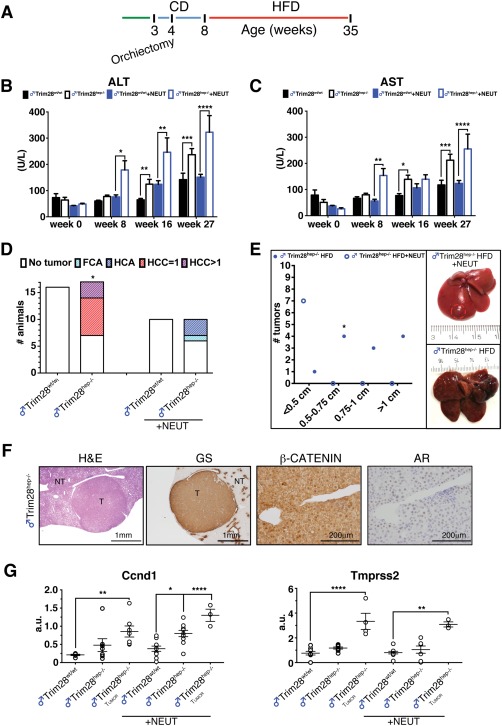Figure 3.

Orchiectomy alleviates tumor burden with persistence of AR signaling. (A) Experimental timeline procedure for the HFD challenge of neutered animals (n = 10). Bilateral orchiectomy was performed at 4 wo and HFD started at 8 wo until final analysis at 35 weeks. (B,C) Serum ALT (B) and AST (C) activity in gonad‐endowed (black‐lined bars) and castrated (+NEUT, blue‐lined bars) animals at different timepoints. *P < 0.05; **P < 0.01; ***P < 0.001; **** P < 0.0001, by two‐way ANOVA followed by Bonferroni's posttest. (D) Tumor classification graph in livers of gonad‐endowed and neutered Trim28hep–/– mice (+NEUT) after HFD challenge. * P value of the Trim28hep–/– versus Trim28hep–/–+NEUT comparison = 0.001611, by Fisher's exact test. (E) Left: tumor size graph in gonad‐endowed (filled circle) and neutered (open circle) Trim28 mutant mice. * P value of the Trim28hep–/– versus Trim28hep–/–+NEUT comparison = 0.0003572, by Fisher's exact test. Right: representative pictures of cancer lesions from gonad‐endowed (bottom) and anorchid (top, adenoma circled in red) mice. (F) H&E and diaminobenzidine stainings for Glutamine Synthase, β‐CATENIN, and AR in HCA of neutered Trim28hep–/– animals. NT, parenchyma; T, tumor. (G) qPCR on liver and tumor biopsies for Ccnd1 and Tmprss2 expression as direct targets of β‐catenin and AR, respectively. Values are calculated as mean relative expression after normalization to three housekeeping genes ± SEM; *P < 0.05; **P < 0.01; ****P < 0.0001, by one‐way ANOVA followed by Bonferroni's posttest. Abbreviations: a.u., arbitrary units; H&E, hematoxylin‐eosin; wo, weeks old.
